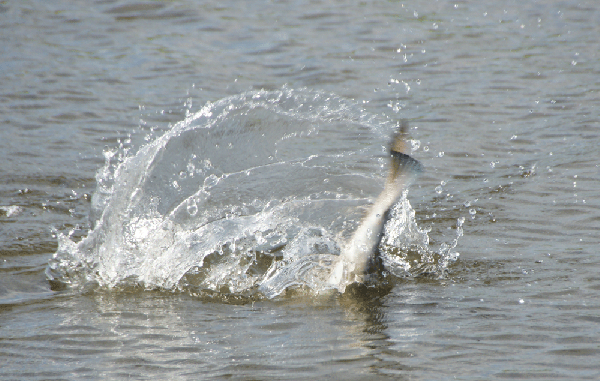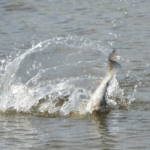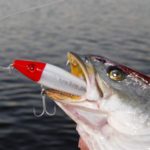
Topwaters great ’yak fishing options
Primetime for topwater action in Southeast Louisiana is here. With the coming of the next few full moons, big female trout will be at their spawning peak and will get extremely aggressive with topwater baits.
And there’s no better way to experience a topwater explosion than sitting on a kayak.
Stealth is a big factor in successful topwater fishing, and a kayak will get you right into the middle of the action without spooking the fish or bait.
The key to finding big trout is to locate schools of mullet. At this time of year, mullet are constantly moving in and through the lakes and bays. Look for them along the shoreline and around the mouth of cuts and bayous.
Also, huge schools of mullet will be found along the beaches of Grand Isle and Elmer’s Island.
Fish the edges of the mullet schools and it’s almost a sure thing that your favorite floating plug will get busted.
There’s no need for a stress test here — the excitement of a topwater explosion will instantly confirm whether or not you have a heart problem.
It’s best not to anchor. Move the kayak quietly along, keeping an eye out for the schools of bait. Once you locate the mullet, stay as far off as you can, and stay with them as they meander along.
Cast along the edges of the bait and not right in the middle where you will spook and scatter the school. A “walk-the-dog” retrieve will almost surely invite a big trout to crash your lure.
There are two schools of thought on what to do if the fish fails to hook up on the first hit.
Some recommend doing nothing and letting the bait sit dead still, as if it has been mortally injured. Oftentimes, the fish will quickly come back for another shot.
Others suggest speeding up your regular retrieve pattern, as if the bait is trying a hurried escape. It usually won’t take long before a second strike comes.
Either method can be effective, depending on the particular mood of the fish.
One of the best things about topwater fishing is that it regularly produces bigger fish. When the conditions are right, full limits of trout can be caught without tying on any other lure.
This is great for kayak fishing, where tackle selection is generally limited. A handful of your favorite colors and sizes is all you need for a successful trip.
In the recent Paddle Palooza kayak tournament in Leeville, Johnny Bergeron was convinced by fellow ’yakers to keep throwing a topwater lure although he had limited experience and little confidence fishing one.
“Up to that morning I had thrown topwater for a total of about five minutes and really had no interest in it, but now I am pretty sure you will see me throwing it a little more often,” Bergeron said.
Why? Because Bergeron caught the largest trout of the 200 tournament contestants at 5 pounds, 14 ounces. He won first place in the trout division and a brand new kayak.
Topwater fishing is usually best in the few days before, during and after the full moon. The increased tidal activity associated with the full moon phase triggers the trout’s spawning activity.
However, trout can be caught at any time on a topwater plug.
Most topwater plugs are armed with two or three large treble hooks. ’Yak fishermen need to take extra precautions when landing a fish caught on one of these lures. The last thing you want is a big fish wielding multiple treble hooks around your nether region.
Rubber “tangle free” landing nets are a great tool for topwater fishing. You can easily and safely get control of the fish without getting the hooks imbedded in the net — or yourself.
Topwater fishing doesn’t require any specialized equipment, but many anglers prefer to have a dedicated combo.
Monofilament in the 15- to 17-pound range works best. Braid can be used, but it’s recommended to use a short length of mono leader to provide a bit of stretch and shock absorption. This helps keep from tearing the lure from a trout’s soft mouth.
Casting reels are much easier to use for precision casting and mastering the dog-walk retrieval technique. Spinning reels will work, but take a little more practice.
Short rod handles are also easier to maneuver through the retrieval motions while sitting in a kayak. Fishing topwater lures requires constant casting and retrieving. Lightweight outfits can help reduce fatigue.
Topwater lures come in a variety of styles and actions. While the most common are those that impart the zigzag, walk-the-dog pattern, others are designed to pop, chug or splash on the surface.
Unlike subsurface plugs, where the entire lure is seen, fish mainly see only the bottom and lower sides of a topwater plug. Therefore, when selecting your favorite colors, the top color is not as important as the bottom color.
Practicing your retrieve is critical. Smooth, rhythmic retrieves produce more strikes than erratic, jerky ones.
When a fish strikes a topwater lure, it’s hard to resist immediately setting the hook. However, you should wait a second or two until you actually feel the weight of the fish.
As noted above, if you miss the hook-up, chances are you’ll get another chance.
Kayaks are great for fighting topwater-caught fish. In addition to your reel’s drag, the weight of pulling the kayak also helps tire the fish and bring it to the net quicker.
Areas you regularly fish in your ’yak are also likely good for topwater action. Concentrate on cuts, points, and especially reefs and other hard bottom areas where trout like to congregate.
Redfish will also readily hit topwater plugs. However, their under-slung mouths sometimes make it difficult to get a hookup. A red trying to crash a topwater bait will actually push the bait away with the wake from its broad head.
All that just makes for more excitement, as they will often strike multiple times before getting hooked.
While topwater action in the ’yak is fantastic, don’t be afraid to get out and wade. The warmer water of spring and summer allows you to get in without the use of waders. Reefs and hard sandy areas are easy to walk and can be very productive.
So if you want some of the most exciting kayak fishing there is, tie on a topwater plug, walk-the-dog next to a mullet school and have some nitro pills handy.


